Exploring Land-Based Kite Surfing: An In-Depth Guide
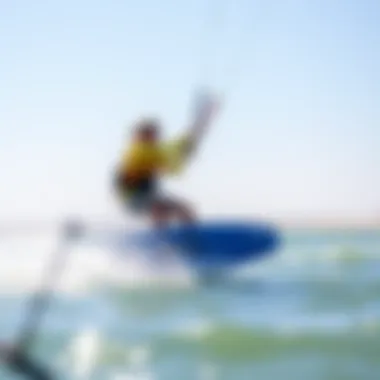
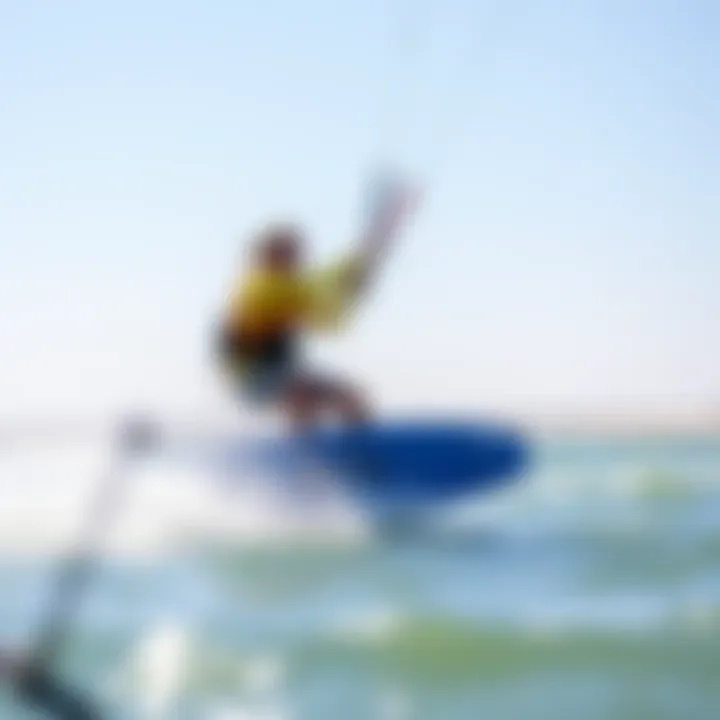
Intro
Kite surfing on land offers a unique thrill, distinct from its water counterpart. It’s an exhilarating way to harness the power of the wind without needing waves. This sport combines elements of speed, agility, and skill, appealing to those who appreciate adventure and the artistry involved in mastering a kite. With proper understanding and the right approach, you can transform an open field into your playground.
The discussions here will envelop the essentials of gear, techniques, and safety, alongside some of the best spots where one can indulge in land-based kite surfing. For the novices stepping into this realm, critical insights will illuminate your journey, while seasoned riders will find new techniques to enhance their skills. Let’s dive into the practical side of land kite surfing, ensuring that whether you are just starting or fine-tuning your abilities, you’ll find valuable nuggets of information.
Gear Insights
Latest Gear Reviews
Choosing the right gear is pivotal. From the kite to the board, each element plays a role in your performance. Recent market trends show the rise of lightweight materials. For instance, kites like the Ozone Access and North Duo have gained attention for their responsiveness and durability.
When shopping, consider:
- Kite Type: Foil kites offer good performance on land and in lighter winds.
- Board Selection: A board with more surface area can provide better stability, especially for beginners.
- Control Bar: A well-designed control bar allows for easier handling and safer rides.
It’s crucial to read reviews and test gear before committing. Users often highlight Liros lines for their reliability and strength, helping kite surfers maintain control during intense moments.
Essential Gear for Beginners
Starting with land-based kite surfing doesn’t mean you need to break the bank. A beginner’s setup can be quite affordable yet effective. Here’s a simple checklist to help you get going:
- A beginner-friendly kite: Look for a 2-4 line kite that’s easy to control.
- Sturdy board: Opt for an all-terrain style that can handle different surfaces, like grass or packed sand.
- Harness: A comfortable harness is vital as it can significantly reduce upper body strain. Look for brands like Dakine or Mystic that offer good support.
Don’t forget about safety gear. Helmets and impact vests not only protect against falls but enhance your confidence while learning. As you progress, conversations with seasoned riders help inform gear choices.
Techniques and Tips
Advanced Tricks and Techniques
Once you're familiar with the basics, it’s time to push your limits. Advanced kite surfers may want to explore techniques like the kiteloop or board-off. The kiteloop demands precise timing and control over the kite to create thrilling airtime.
Tips for mastering these techniques include:
- Practice regularly: Find open spaces where you can hone skills without distractions.
- Analyze videos: Watching both your footage and professionals can sharpen your understanding of technique.
Safety Practices for Kiteboarders
Safety should always be a priority, whether you're flying high or just getting started. Pay attention to wind conditions and choose suitable locations. Never underestimate the power of the wind. Awareness of your surroundings is crucial. Always look out for:
- Other kite surfers, trees, and obstacles that may influence your flight path.
- Changes in wind speed or direction that could alter your trajectory unexpectedly.
"Safety is not just about avoiding accidents; it's about enhancing your experience and enjoyment."
It’s wise to have a basic first aid kit on hand, including items for minor cuts and scrapes that could happen when you're learning. Good practices lead to safer experiences, allowing for years of enjoyment in what can often be a rugged sport.
Stay connected with the community through platforms like Reddit and Facebook, where insights and advice flow freely. Engaging with fellow land kite surfers can provide motivation and deepen your appreciation for the sport.
Understanding Land-Based Kite Surfing
Land-based kite surfing is a fascinating sport that opens up a world of thrill and adventure. By understanding its nuances, practitioners can fully appreciate not only the excitement but also the skills required to master it. Unlike its water-bound counterpart, land kite surfing offers an entirely different experience, driven by varying environmental conditions and distinct equipment. Engaging with this sport can lead to fresh perspectives on wind dynamics, board control, and personal limits.
In this section, we will explore the definition and overview of land-based kite surfing, followed by its historical context. This exploration sets the stage for a deeper dive into techniques, gear choices, and safety measures, ultimately enriching the experience for both newcomers and seasoned enthusiasts.
Definition and Overview
Land-based kite surfing involves using a kite to harness wind power while riding on various surfaces such as grass, sand, or dirt. It combines elements of traditional kiteboarding with unique twists. Riders attach themselves to a specific type of board designed for different terrains, employing shifting winds to glide, jump, and perform tricks. The current popularity of this sport can be attributed to its accessibility; individuals can practice it in a variety of locations, where water sports may not be feasible.
Benefits of engaging in land-based kite surfing include:
- Versatility: One can easily find suitable locations and adjust techniques according to the environment.
- Skill Development: Riders enhance navigation and control skills that can translate to better performance in other kite sports.
- Community Connection: Participating in land kite surfing creates bonds amongst fellow enthusiasts, fostering a sense of belonging and mutual encouragement.
Historical Context
The roots of land-based kite surfing can be traced back to the advent of kite flying itself. Kites have been used for centuries, originating in ancient China. Over time, they evolved into various forms, leading to unique recreational activities. In the past few decades, innovations in kite design and materials led to the evolution of sports like kiteboarding and its land-based variation.
The late 20th century saw a surge in interest in outdoor extreme sports, with a focus on harnessing wind energy. Land-based kite surfing began to gain traction as enthusiasts experimented with different types of equipment, adapting traditional kiteboarding techniques for land.
From humble beginnings, this dynamic sport has carved its niche, allowing adventurers to enjoy the rush of wind underfoot and the thrill of performance. Therefore, it’s vital to recognize how this sport evolved, as it reflects not just hashtag trends but a community’s collective spirit and determination.
"With each gust of wind, they redefine limits and chase freedom, carving their path on the earth"
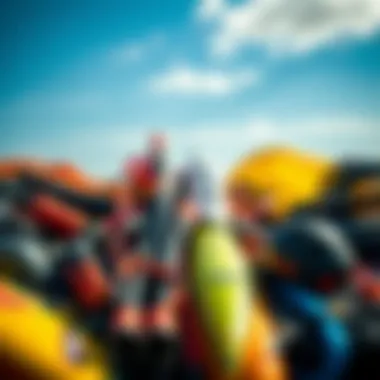

This historical backdrop also brings attention to the nature of innovation. As techniques improved, so did the gear, resulting in the high-quality equipment that today’s riders utilize, marking a significant departure from the early configurations. Embracing this past can enhance one's understanding and appreciation of land-based kite surfing as it stands today.
Key Differences Between Land and Water Kite Surfing
When it comes to kite surfing, distinguishing between land and water variations is crucial. While both share core principles, a number of factors separate the two, influencing gear selection and technique. Understanding these differences helps participants adapt their skills and optimizes their kite surfing experience.
Environmental Factors
Wet and dry terrains create unique experiences for kite surfers. The primary environmental difference is surface type. Water is fluid and can produce waves, which are both a challenge and a thrill. Conversely, land surfaces are more stable. Riding on grass fields, sand dunes, or even hard-packed dirt can provide distinct friction levels affecting speed and control.
Wind plays a significant role in both settings too. On water, wind interacts with the surface waves, creating potential gusts and lulls. On land, the influence of obstacles like buildings or trees can cause wind patterns to shift unpredictably. Therefore, practitioners should learn to read wind conditions specific to each environment.
The surrounding climate impacts riding conditions as well. For instance, a hot sunny day provides perfect conditions at a beach while dry wind in a rural area can create dust storms. Adjusting to local climates is essential for safe and enjoyable riding.
"Knowledge of your environment is key; whether you're skimming across waves or gliding over fields, understanding the surroundings can transform your experience."
Equipment Variations
The differences extend beyond just the riding environment. The gear used for land-based kite surfing diverges significantly from that used on water. The kites themselves may be similar, but their application can vary. Generally, land kites are built to handle higher speeds and stronger winds, offering more lift to conquer the flatter terrain. Foil kites, commonly used in land kite surfing, are prevalent; they have an effective shape that maximizes lift with less drag, allowing surfers to harness the wind efficiently.
Boards reflect another departure. Land boards tend to have larger wheels or a solid surface to glide smoothly across land while maintaining stability at higher speeds. Water boards typically have fins to help with navigation through waves, a feature that would be less valuable on flat non-water surfaces.
Moreover, protective gear is more critical in the land sport due to the potential for falls on hard ground. Helmets and pads are often essential for safety, whereas in water sports, buoyancy eliminates some of these risks.
Closure
The key differences between land and water kite surfing are foundational for both newcomers and seasoned riders. Gaining an understanding of these nuances allows kite surfers to tailor their equipment and techniques, making their experiences more satisfying and secure. 🪁
Resources for further reading include:
Incorporating this knowledge fosters a deeper appreciation of both forms of kite surfing, enriching the overall adventure.
Essential Gear for Land-Based Kite Surfing
In the exhilarating sport of land-based kite surfing, having the right essential gear can make the difference between a thrilling experience and a frustrating one. The equipment not only enhances performance but also ensures safety and comfort while riding. When you step onto the field or beach with confidence, every moment spent harnessing the wind feels more rewarding. Focusing on specific elements like kites and boards underpins the importance of understanding their roles and variations to optimize your experience. This section will delve into kites and boards, examining their types and unique features.
Kites
Types of Kites
Kites come in various designs and sizes, each tailored for different conditions and riding styles. The two predominant types of kites are foil kites and leading-edge inflatable (LEI) kites. Foil kites are more lightweight and often better for beginners due to their simplicity and ability to stay aloft even with less wind. On the other hand, LEI kites are robust and versatile. They inflate and provide structure, enabling greater stability and performance in a wide range of conditions.
One noteworthy aspect of these kites is their wind range. For instance, a foil kite can handle lighter winds remarkably well, making it a popular choice for those just starting. In contrast, LEI kites, while challenging to launch and land, excel in higher winds, which suits seasoned riders seeking speed and power. Each kite type has its unique advantages and disadvantages, making it essential for riders to understand their specific needs and conditions before selecting.
Selecting the Right Size
Choosing the right kite size is another critical factor that influences performance. The kite's size directly affects its power and controllability, which varies depending on wind speed and rider weight. Larger kites generate more power and are typically preferred in lighter winds, while smaller kites offer more maneuverability in stronger winds. As a general guide, a rider weighing around 150 pounds generally benefits from a kite in the 9 to 12-meter range for most conditions.
This choice isn't solely about the dimensions but also involves understanding the unique features of each kite. For example, larger kites tend to have a slower response time, which may chaotically affect control. Meanwhile, smaller sizes provide acute responsiveness, allowing for swift turns and tricks. So, evaluating your weight against the wind conditions of your preferred location is crucial for optimal performance and safety.
Boards and Other Equipment
Board Types
While kites are vital, the board is equally important in the equation of successful land kite surfing. Boards differ fundamentally in shape, size, and construction, which contribute to different riding experiences. Common types include directional boards and twin-tips. Directional boards are designed for more advanced riders, focusing on surfing-like maneuvers. Twin-tips, on the other hand, cater to beginners and intermediates with their symmetrical design, allowing for easy riding in both directions.
One significant characteristic of twin-tips is their ability to improve balance, enabling beginners to build confidence without feeling overwhelmed. In contrast, directional boards can offer the thrill of carving through the terrain once riders have mastered the fundamental skills. Evaluating the board type suited to your experience contributes immensely to your enjoyment and development.
Protective Gear
Safety should always sit at the forefront, and protective gear plays a paramount role here. Essential items such as helmets, knee pads, and impact vests can be lifesavers in the event of a fall. Beyond mere comfort, they provide essential support during your initial learning curve and beyond. Helmets, in particular, are vital in protecting against potential head injuries in case of a mishap. Similarly, knee pads provide cushioning against impacts, giving riders the chance to enjoy longer sessions without excessive discomfort.
The unique feature of protective gear is its necessity regardless of skill level. Even seasoned professionals find themselves in tough spots, so having the right safety equipment not only ensures protection but also builds confidence to take on new challenges. While it may add some weight and a bit of a learning curve initially, the benefits far outweigh any disadvantages.
Having the right gear isn’t just about performance; it’s about embracing the adventure of kite surfing with peace of mind.
Basic Techniques for Land Kite Surfing
When embarking on the adventure of land kite surfing, grasping the basic techniques is the crux of your experience. This not only ensures your safety but also enhances the thrill of mastering the sport. The main ideas we’ll be looking at include getting started effectively, maintaining control, and progressing to advanced maneuvers. Each technique is a stepping stone that builds your confidence and skill level, making the journey much more enjoyable.
Getting Started
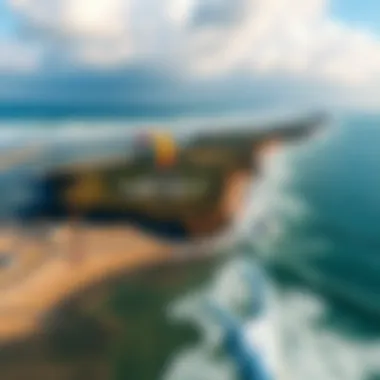
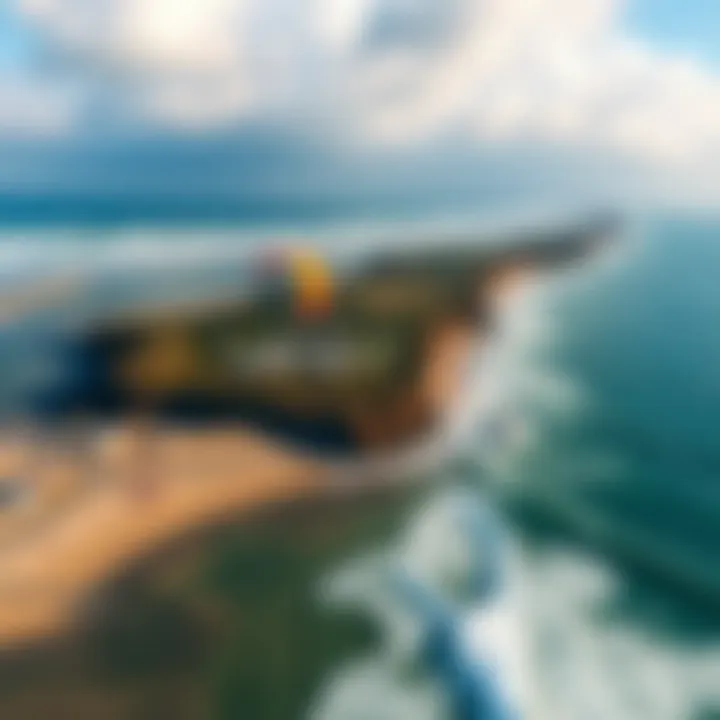
Starting off on the right foot is key to long-term enjoyment in this sport. Make sure you choose a suitable location with ample open space, free from hazards like trees or buildings. Before you even think about launching your kite, familiarize yourself with how the kite works and the wind conditions. This might sound like a no-brainer, but knowing if it’s too gusty or too weak can save you from a troublesome session.
Practice setting up your equipment on the ground, understanding how to launch and land the kite safely. Get a good feel for how the kite behaves in various wind conditions. It’s advisable to start with smaller kites, as they’re often easier to handle and help you learn the ropes without too much power spinning you out of control.
Mastering Control
Once you have the basics down, mastering control is the next order of business. It’s all about getting comfy with the power of the kite and its responsiveness to your movements. Engage in simple drills that feel effortless yet allow you to understand the nuances of inputting power through your body—where to lean, how to steer, and when to pull on the bar.
Practice makes perfect, so take your time to develop muscle memory. Being able to maintain control in varying wind conditions sets the groundwork for more advanced techniques. For instance, learn about power zones—understanding where the most pull comes from and how to navigate your kite within these zones can entrust you with the confidence to progress further.
Advanced Maneuvers
As you become more adept and comfortable with basic sailing and kite control, you can shift your focus towards advanced maneuvers that elevate your skill level. This segment’s about pushing limits and incorporating style.
Jumping Techniques
Jumping techniques can be a game-changer for many land kite surfers. They create excitement and provide a great sense of accomplishment. Key to this technique is generating the right amount of lift and timing your launch. An essential aspect is ‘the pop’—using your legs to press against the board while pulling on the kite to attain lift.
One cannot ignore the practice required to get down your timing. The standout characteristic of jumping is the exhilarating feeling of being airborne. However, it’s critical to make a controlled landing to avoid mishaps. Jumping opens doors to further tricks and combinations, solidifying its appeal among practitioners.
Tricks and Spins
Tricks and spins add flair to your kite surfing repertoire. They significantly contribute to the overall visual impact of your performance—engaging the audience and perhaps even getting a nod of approval from peers. The crux of successfully executing tricks lies in blending your board maneuvers with your kite control. Understanding how to position your body and kite together is crucial.
One unique feature of tricks is their potential for expressiveness. You can personalize including spins, flips, or stylistic landings, which can also be a point of advantage and creative expression in competitions.
Yet, as with any thrilling maneuver, there's a risk involved. Mastery often requires rigorous practice and could lead to falls and tumbles—however, these are often part of the learning curve, forming lengthy stories shared around the fire after a day on the field.
"The learning never stops in kite surfing, where every mistake leads to greater understanding of the sport and oneself."
By focusing on these basic techniques of land kite surfing, you lay the foundation for a rewarding and exhilarating journey. Each skill enhances your experience, making you not only a better kite surfer but also a more aware and connected member of the kite surfing community.
Safety Considerations for Land Kite Surfing
Safety in land kite surfing sometimes takes a backseat amid the excitement of soaring kites and open landscapes. However, it cannot be stressed enough; being smart about safety can mean the difference between a thrilling adventure and a potential catastrophe. As kite surfers take to fields, beaches, and other open spaces, understanding the inherent risks involved is paramount. This section covers essential factors to ensure a safe and enjoyable experience.
Understanding Risks
When it comes to land kite surfing, the risks are often amplified by the environment. Unlike water, where you have the buoyancy to cushion falls or unexpected tumbles, the ground can be unforgiving.
- Wind Variability: Wind, while vital for flying the kite, can also be unpredictable. Sudden gusts can catch even the most experienced kite surfers off guard, potentially leading to injuries.
- Physical Injuries: Falls are a common issue, particularly when learning to control the kite. Scrapes, bruises, or even fractures may occur if one loses balance or encounters a sudden shift in wind.
- Environmental Hazards: Depending on the chosen location, obstacles like trees, fences, or rough terrain can pose significant dangers. They can obscure visibility and lead to collisions or crashes contributing to injuries.
Being aware of these risks helps riders prepare properly and make informed decisions about when and where to surf.
Preventive Measures
A safe kite surfing experience hinges on proactive measures and proper planning. By taking steps to mitigate risks, individuals can greatly enhance their adventure.
Wind Conditions
Understanding Wind Conditions is crucial for any kite surfing activity. Wind strength and direction can decide whether a session will be a delightful ride or a disastrous outing. Knowing the general forecast and ongoing real-time conditions helps surfers select the best time to hit the ground.
- Ideal Wind Ranges: Generally, a wind speed of 10 to 25 knots is considered ideal for land kiting. Too little wind makes it difficult for the kite to lift, while too much can be unsafe.
- Monitoring Weather Changes: A key trait of advantageous wind conditions is their consistency. Sudden gusts or shifts can happen; hence checking regular updates can save one from dangerous predicaments.
- Wind Zones: Choosing spots with open fields where wind can flow freely without obstruction contributes greatly to a safer experience. Avoid areas with tall structures, as they can create turbulence.
Obstacles
Apart from wind, Obstacles represent another significant risk during land kite surfing. Whether natural or man-made, being aware of one’s surroundings is essential to navigate safely.
- Awareness of Environment: Before getting started, it’s essential to survey the chosen area. Look for potholes, rocks, or bushes that can get in the way and potentially lead to a nasty spill.
- Clear Landing Areas: Ensuring that there is a clear path for landing the kite is vital. This can prevent unexpected mishaps that could lead to injuries.
- Etiquette and Awareness: Understanding the community dynamics—keeping an eye on other surfers and respecting shared space—is vital to avoiding collisions or creating hazards for others.
Inbrief, the blend of understanding wind conditions and assessing potential obstacles forms the backbone of a safer kite surfing experience. Whether you’re just starting or are more experienced, taking these precautions can safeguard your adventures on land.
Ideal Locations for Land Kite Surfing
Choosing the right location for land-based kite surfing can make all the difference between a memorable experience and one that is less than ideal. The various elements influencing your choice can include wind conditions, terrain type, and the overall accessibility of the area. The right spot not only amplifies the thrill of the sport but also ensures safety and enjoyment. Knowing the best locations can open wide avenues for kite surfing, enabling enthusiasts to enjoy the wind in their hair and the freedom of the open land.
Beaches and Coastal Areas
Beaches and coastal areas are often associated with traditional kite surfing, but they offer something unique for land-based kite surfing too. With vast stretches of flat sand, these locations typically have reliable wind conditions. On top of that, the open space allows for clear visibility, which is an essential safety consideration.
- Wind Consistency: Coastal areas tend to have consistent wind. The sea breeze can create a stable environment for land kiters, which enhances the overall riding experience.
- Atmosphere: The beach vibe is often lively and bustling, providing a fantastic backdrop. It’s not just about the sport; it’s about joining a community of like-minded individuals enjoying the outdoors.
- Variety of Terrain: Beaches can offer different kinds of surfaces—from packed sand to harder ground, allowing racers to choose what best suits their skills.
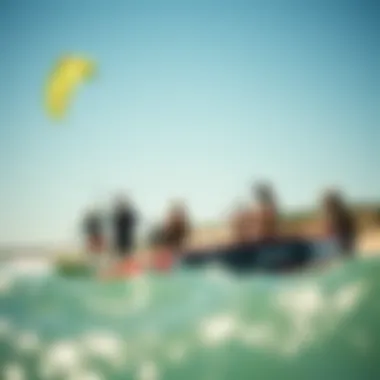
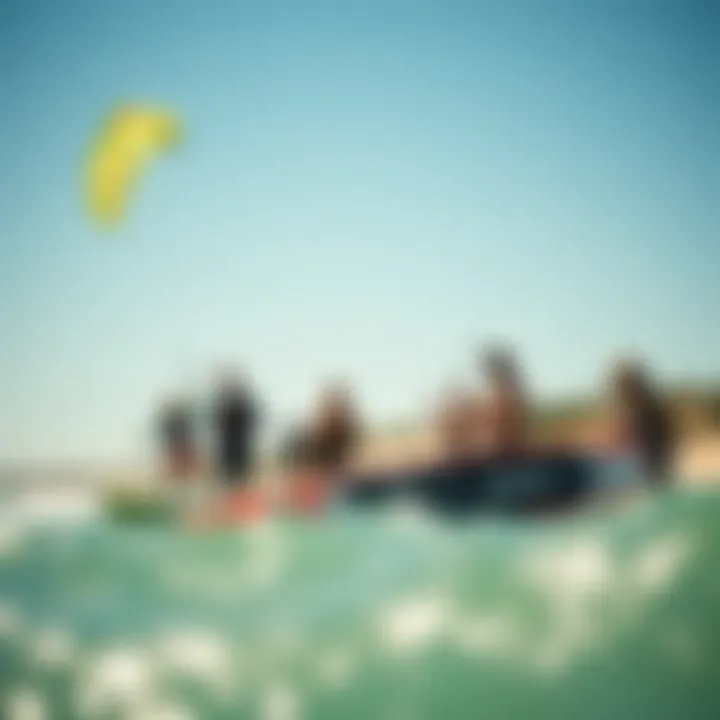
However, it's crucial to remain aware of certain factors, such as:
- Local regulations concerning kiting on the beach
- Presence of pedestrians or swimmers
- Natural obstacles like dunes or rocks that may pose risks
Open Fields and Parks
Open fields and parks are another incredible choice for land-based kite surfing. They give you the advantage of space—oftentimes, you'll find vast, flat landscapes with minimal obstructions, making them perfect for the sport.
- Space to Maneuver: With wide open fields, there is room to practice and perfect maneuvers without fear of intruding into pedestrian areas.
- Accessibility: Most parks are easily accessible, often equipped with parking facilities, making them suitable for a quick session whenever the weather’s just right.
- Family-Friendly: Parks can also be dynamic locations where families can enjoy various activities together. You might find picnickers, dog walkers, and fellow adventurers, adding an element of social engagement to your kite surfing adventure.
Remember: Always check the park’s regulations. Some places may require permits or have restrictions on equipment use.
Exploring these locations allows kite surfers to fully embrace the thrill of this sport while ensuring a safe and enjoyable atmosphere. Whether gliding across sandy shores or racing across grassy fields, each location offers a different flavor of kite surfing experience.
Kite Surfing Community and Culture
The landscape of kite surfing isn't just shaped by winds and waves; it's also molded by the vibrant community of enthusiasts who make this sport what it is. Being part of a community can elevate your experience, providing support, motivation, and friendships that extend beyond the kiteboarding session. The culture surrounding land-based kite surfing is unique and influential, creating an environment where newbies and seasoned riders alike can exchange tips, stories, and a shared passion.
Connecting with Other Enthusiasts
One of the greatest advantages of being involved with the kite surfing community is the chance to connect with fellow riders who share your love for the sport. Local meet-ups and informal gatherings often pop up at popular locations, creating a casual atmosphere where everyone can come together. Here, you can learn about different techniques, gear choices, and personal experiences that can only come from those who’ve navigated the same challenges you might be facing.
Online platforms, too, play a big part in fostering these connections. Websites like Reddit often have dedicated threads for kite surfers, allowing users to ask questions, share tips, or simply connect. Social media platforms like Facebook have numerous groups where riders post about their local spots, gear swaps, and even safety tips. Not only do these connections enhance your skill set, they can also lead to lifelong friendships.
"The wind is like a friend; sometimes it’s gentle, sometimes it’s wild. Riding with others makes every gust feel like an adventure together."
When you engage with local and international kite surfing communities, it’s like adding wind to your sails. It fosters a collaborative spirit and encourages riders to push their boundaries. Sharing an experience with others, whether it’s a spectacular sunset session or the thrill of landing a new trick, brings a sense of camaraderie that enhances your journey through kiting.
Events and Competitions
Participating in events and competitions is another pivotal aspect of the kite surfing culture. They are more than just competitions; they’re festivals that celebrate the sport and bring the community together in an electric atmosphere. Whether you are competing or just watching, these gatherings are filled with energy, inspiration, and a chance to learn from the best.
Events often include clinics, where seasoned pros offer workshops on various skills, equipment choice, and safety considerations. These experiences provide invaluable knowledge to up-and-coming kite surfers and create a competitive yet supportive environment.
Moreover, competitions can sometimes lead to unexpected friendships and collaborations. When riders from different backgrounds showcase their talents and techniques, it’s a treasure trove of learning opportunities. Engaging in this spirited competition hones not just your skills but embodies the essence of the kite surfing culture: a mix of personal growth, community bonding, and shared passion.
In summary, being part of the kite surfing community and participating in local events enriches the overall experience. This culture fosters connections, learning, and mutual encouragement that enhances every session, making riding not just about the sport but about the people who share it.
Resources for Further Exploration
In the pursuit of mastering land-based kite surfing, one cannot understate the value of resources available that go beyond basic tutorials. Exploring various channels of information can dramatically enhance your understanding and skills in this exhilarating sport. Engaging with communities and absorbing knowledge from books and videos offers a multi-faceted approach to learning. The world of kite surfing is vibrant and ever-evolving, making these resources essential for anyone keen on riding the wind.
Online Forums and Communities
Online platforms serve as invaluable hubs for kite surfing enthusiasts to exchange tips, share experiences, and offer support. Websites like reddit.com have dedicated subreddits such as r/Kitesurfing, where both amateur and experienced riders congregate to discuss techniques, gear recommendations, and safety measures. It’s a melting pot of ideas, fostering a sense of camaraderie among kite surfers from different backgrounds.
Additionally, joining Facebook groups tailored to land-based kite surfing can help you stay updated on trends and local events. Group chats are often buzzing with information about best practices and recent innovations in gear. Connecting with others not only provides knowledge but can also lead to potential kiteboarding partners for practice sessions.
Each interaction gives you a chance to expand your understanding, ultimately refining your technique and strategy on land. Don't shy away from posting questions or sharing your own insights—it's a great way to contribute to the community.
Books and Videos
When it comes to honing skills and gaining deeper insights into the sports mechanics, investing time in literature and instructional videos can pay off handsomely. Books such as "The Complete Kitesurfing Handbook" serve as great starting points, covering everything from basic setups to advanced maneuvers. These resources often break down complex ideas into digestible pieces, allowing you to absorb at your own pace.
Video tutorials on platforms like YouTube can also provide visual guidance that written text sometimes cannot deliver effectively. Channels might showcase everything from beginner basics to advanced tricks like jumping techniques and spins, catering to various skill levels. Following seasoned kite surfers on these platforms can offer tips and hacks that further enrich your practice.
In summary, tapping into these resources can cultivate a richer understanding of land-based kite surfing. By engaging in communities and diving into comprehensive literature or visual content, you'll find yourself better equipped to navigate both the winds and challenges of this thrilling sport.
Always remain curious and open to learning—every piece of knowledge feeds into your overall kite surfing prowess!
Closure and Future Directions
As we look to the horizon of land-based kite surfing, it is vital to understand how this exhilarating sport is evolving and what lies ahead for enthusiasts. The conclusion of this guide emphasizes not just a summary of the journey we've taken through techniques, equipment, and community engagement, but also the importance of staying attuned to the currents shaping this world of kite surfing.
Current Trends in the Sport
The present landscape of land-based kite surfing is constantly changing, influenced by developments in technologies, techniques, and even environmental concerns. To paint a clearer picture of what's happening today, here are some notable trends:
- Eco-Friendly Equipment: There is an increased focus on sustainable materials, with brands like Ozone and Switch Kites introducing products made from recycled materials. This shift reflects a growing awareness in the kite surfing community about the environmental impacts of materials used in the sport.
- Hybrid Kitesurfing Styles: More folks are melding land and water techniques, leading to the rise of hybrid disciplines. Riders who once specialized exclusively in one area begin to explore the versatility of their skills on various terrains. This cross-pollination is enriching the skill sets within the community.
- Enhanced Training Resources: With the migration of tutorials and instructional resources to online platforms, more people are gaining access to higher-quality teaching. Websites such as YouTube have become treasure troves of information, providing everything from beginner tips to advanced maneuvers.
"Kite surfing is not just a sport; it’s a lifestyle. Embracing new trends helps keep that lifestyle fresh and vibrant."
Potential Innovations
Looking forward, the future of land-based kite surfing seems ripe for a multitude of innovations that could alter the way we participate in this thrilling activity:
- Smart Kites: The advent of IoT in sports gear is on the rise. Imagine kites equipped with sensors that provide live feedback on performance metrics such as wind speed, pull strength, and aerial balance. These kites could sync with apps and offer real-time guidance to riders, pushing personal limits way further.
- Virtual Reality Training: As virtual reality tech becomes more affordable and accessible, it could revolutionize learning. VR simulations could help novice riders grasp basic maneuvers without the risks associated with actual runs, making the learning curve less daunting.
- Community Platforms: Enhanced online platforms could allow for a more robust sharing of techniques and experiences. Imagine a social network space dedicated solely to kite surfers, where riders can share their accomplishments, set meet-ups, and even tackle challenges together globally.
In summary, understanding the current trends and anticipating the innovations on the horizon sheds light on the dynamic nature of land-based kite surfing. As the gear and techniques continue to advance, so too does the community surrounding this electrifying sport. Those who engage with it—whether they are new riders or seasoned veterans—can look forward to a thrilling journey into the future of kite surfing.















